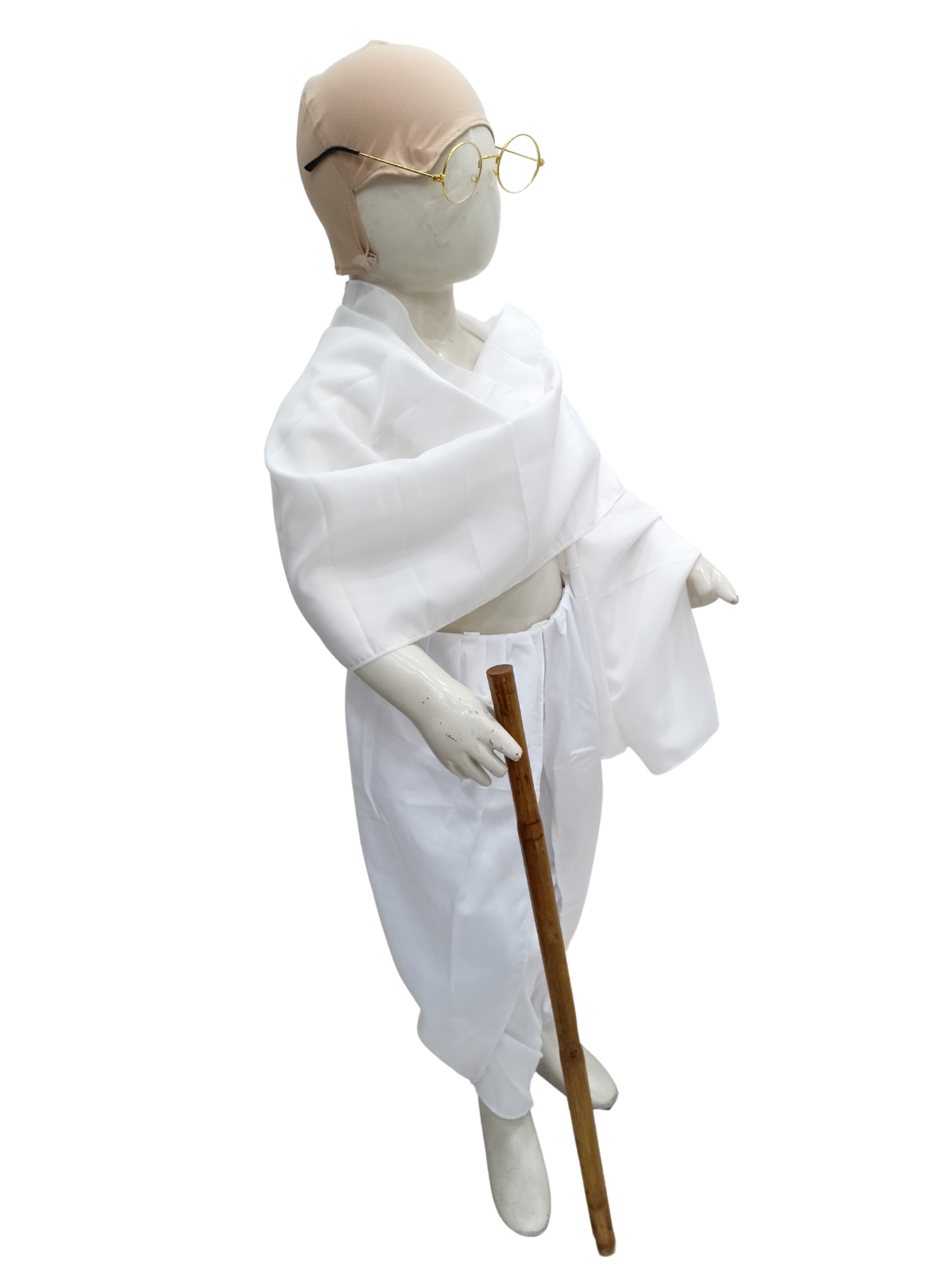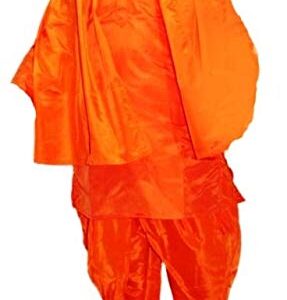Your cart is currently empty!
Mahatma Gandhi Costume
₹549.00
Description
Mahatma Gandhi (2 October 1869 – 30 January 1948) was the preeminent leader of Indian nationalism in British-ruled India. Employing nonviolent civil disobedience, Gandhi led India to independence and inspired movements for civil rights and freedom across the world. The honorific title Mahatma—meaning “Great Soul”—was bestowed upon him first in 1914 in South Africa, and became widely used in India in the 1920s.Gandhi is internationally honored for his philosophy of nonviolence and his leadership of the Indian independence movement. He is often called Mahatma Gandhi, which means “Great Soul” in Sanskrit. Gandhi is considered the father of modern India.
Gandhi was born in Porbandar, Gujarat, India, on October 2, 1869. He was the youngest son of Karamchand Gandhi, the chief minister of Porbandar, and Putlibai. Gandhi was educated in Porbandar and Rajkot. In 1887, he went to England to study law. He returned to India in 1891 and began practicing law in Bombay.
In 1893, Gandhi went to South Africa to represent a Muslim client in a court case. While in South Africa, Gandhi experienced firsthand the discrimination and racism faced by Indians living under British rule. He began to lead protests against this discrimination, and he developed his philosophy of nonviolence.
Gandhi returned to India in 1915. He quickly became a leader of the Indian independence movement. He led protests against British rule, and he also worked to improve the lives of India’s poor and oppressed.
Gandhi’s philosophy of nonviolence was based on the belief that all people are equal and deserve to be treated with respect. He believed that violence was never the answer, and that even the most difficult problems could be solved through peaceful means.
Gandhi’s nonviolent protests were often successful in achieving their goals. In 1930, he led the Salt March, a protest against the British salt monopoly. The Salt March was a major turning point in the Indian independence movement, and it helped to galvanize Indian support for independence.
Gandhi continued to lead protests against British rule until India finally gained its independence in 1947. After independence, Gandhi worked to promote Hindu-Muslim unity. He was assassinated by a Hindu extremist on January 30, 1948.
Gandhi’s legacy is one of nonviolence, peace, and social justice. He is considered one of the most important figures in Indian history, and his influence is felt around the world.
Gandhi’s Contributions to India
Gandhi’s contributions to India are numerous and far-reaching. He is credited with leading India to independence, and he is also credited with helping to shape modern India.
Gandhi’s nonviolent protests were a major factor in India’s independence. He showed the world that it was possible to achieve political change without violence.
Gandhi also worked to improve the lives of India’s poor and oppressed. He promoted self-reliance and economic development, and he also worked to improve education and healthcare.
Gandhi’s philosophy of nonviolence has had a lasting impact on India. It is still used today by activists and social movements.
Gandhi’s Legacy
Gandhi’s legacy is one of peace, nonviolence, and social justice. He is considered one of the most important figures in Indian history, and his influence is felt around the world.
Gandhi’s philosophy of nonviolence has been adopted by movements for civil rights and freedom around the world. It has been used by activists in South Africa, the United States, and other countries to fight for their rights.
Gandhi’s teachings are still relevant today. They offer a way to achieve social change without violence.
Mahatma Gandhi’s attire was as significant as his principles of non-violence and self-reliance. His clothing choices evolved throughout his life, reflecting his changing circumstances and evolving philosophy. Here’s a breakdown of what he typically wore:
Early Years:
- Western Suits: In his early years, especially during his time in South Africa, Gandhi wore Western suits and hats, reflecting the societal norm at the time.
- Dhoti and Kurta: However, even then, he started incorporating Indian clothing, occasionally opting for a simple dhoti and kurta.
Adopting Khadi:
- Simple Dhoti: After returning to India and embarking on his political journey, Gandhi adopted a plain white dhoti as his staple garment. This choice symbolized his commitment to simplicity, self-sufficiency, and identification with the masses.
- Khadi Fabric: The dhoti was made of khadi, a handwoven cotton fabric he championed as a symbol of Swadeshi (promoting Indian-made goods) and economic empowerment.
- Chappals: He typically wore sandals called chappals for footwear, again opting for practicality and simplicity.
Later Years:
- Gandhi Topi: Later on, the iconic “Gandhi topi” became a prominent part of his attire. This simple white cap made of khadi became a symbol of his movement and was widely adopted by his followers.
- Shawl: In colder weather, he added a khadi shawl for warmth, often draped over his shoulder.
Overall Impact:
- Symbol of Identity: Gandhi’s attire transcended mere clothing, becoming a powerful symbol of his beliefs and identity. It represented his dedication to Indian traditions, self-sufficiency, and the empowerment of the common people.
- Inspiring Others: His simple choices inspired millions to adopt khadi and Indian fabrics, promoting economic independence and national pride.
- Legacy of Simplicity: Even today, Gandhi’s attire remains a powerful visual reminder of his principles of simplicity, self-reliance, and dedication to the greater good.
It’s important to remember that while these are the general outlines of Gandhi’s attire, there might be variations depending on specific occasions or photographs available. He also experimented with different styles and textures of khadi throughout his life.





Reviews
There are no reviews yet.